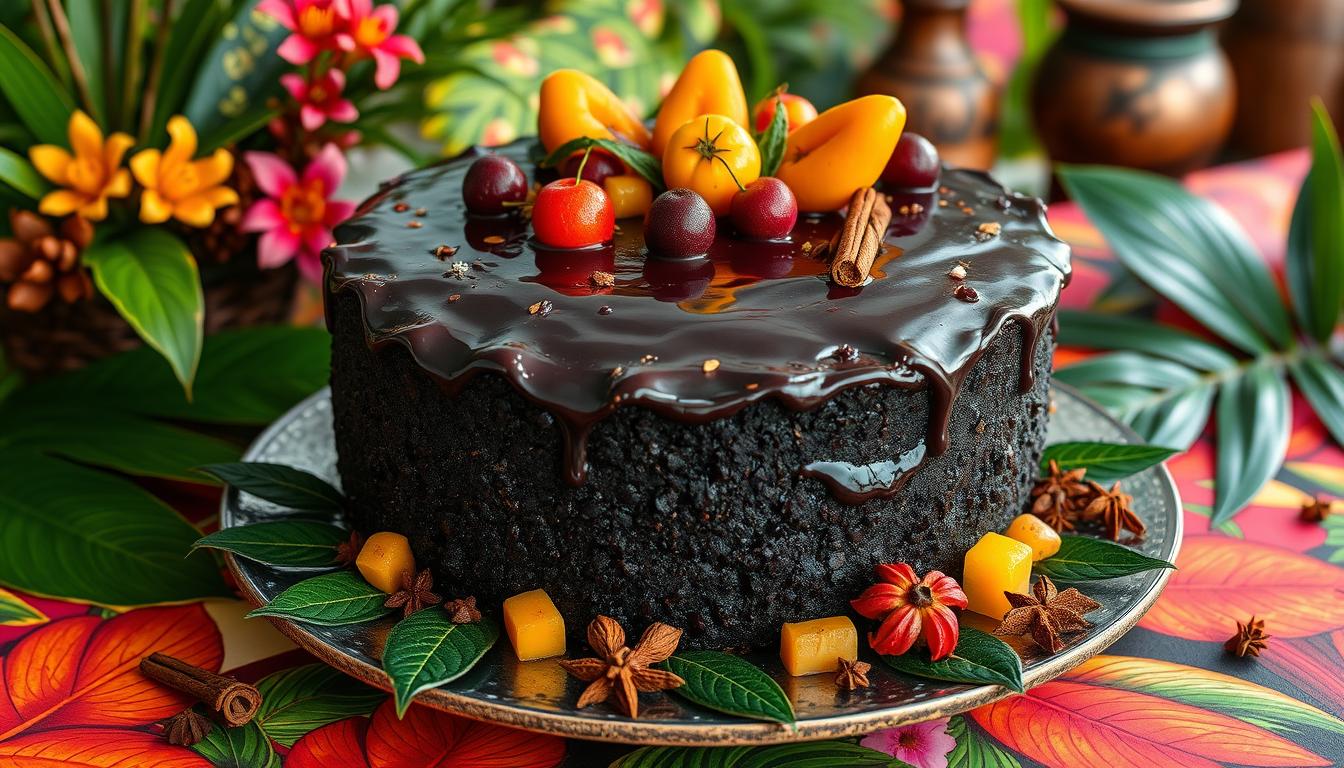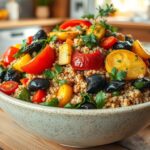Every holiday season, the smell of authentic Caribbean black cake fills kitchens everywhere. It’s not just a dessert; it’s a storyteller of generations. When you try this traditional rum cake, you’re not just eating a sweet treat. You’re connecting with a rich cultural legacy that crosses continents and generations.
The authentic Caribbean black cake is more than a dessert. It stands for family gatherings, shared memories, and the vibrant culinary heritage of Caribbean communities. From Brooklyn to Birmingham, this cake connects people across borders with its unique taste and preparation.
Imagine a cake so rich with rum-soaked fruits that each bite shares a story of patience, love, and pride. The traditional rum cake starts its journey months before Christmas. It begins with careful fruit preparation that turns simple ingredients into a masterpiece.
Key Takeaways
- Authentic Caribbean black cake is a cherished holiday tradition
- Preparation begins months before Christmas
- The cake represents cultural connection and familial bonds
- Rum-soaked fruits are essential to its unique flavor profile
- Each cake tells a story of Caribbean culinary heritage
Understanding the Rich Heritage of Caribbean Black Cake
The west indian fruitcake has a fascinating story. It comes from British colonial history. This cake is more than a dessert; it’s a story of Caribbean culture.
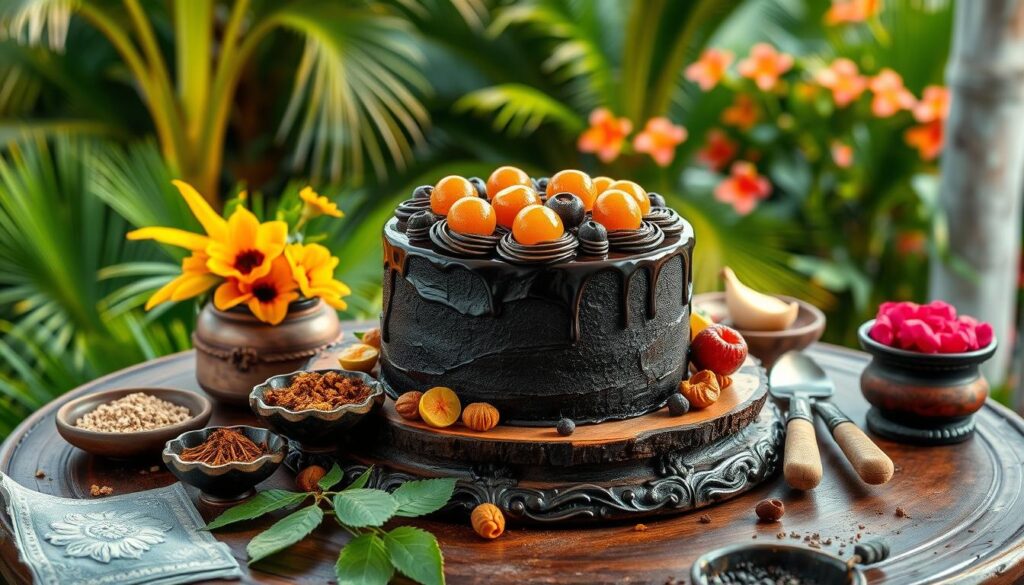
Caribbean people changed the British figgy pudding into something special. This change happened during the colonial era. They mixed European cooking with local tastes and ingredients.
Origins from British Culinary Traditions
The cake’s roots are in British plum pudding, brought by European settlers. Key changes included:
- Using local dried fruits
- Adding Caribbean rum and wine
- Making it denser and more flavorful
Evolution in Caribbean Culture
As the west indian fruitcake evolved, it became a symbol of resilience and creativity. Caribbean bakers made it their own by using:
- Locally sourced dried fruits
- Plenty of rum and spirits
- Unique spice mixes
Significance in Celebrations
The caribbean christmas cake is more than a dessert. It stands for community, tradition, and shared experiences. Families spend weeks making it, turning preparation into a celebration.
“A slice of black cake is a slice of Caribbean history”
| Occasion | Significance |
|---|---|
| Christmas | Primary celebration |
| Weddings | Symbol of prosperity |
| Anniversaries | Family gathering tradition |
The journey of this remarkable cake shows the Caribbean’s rich culture. It’s a delicious story of adaptability, creativity, and community spirit.
Essential Ingredients for Traditional Black Cake
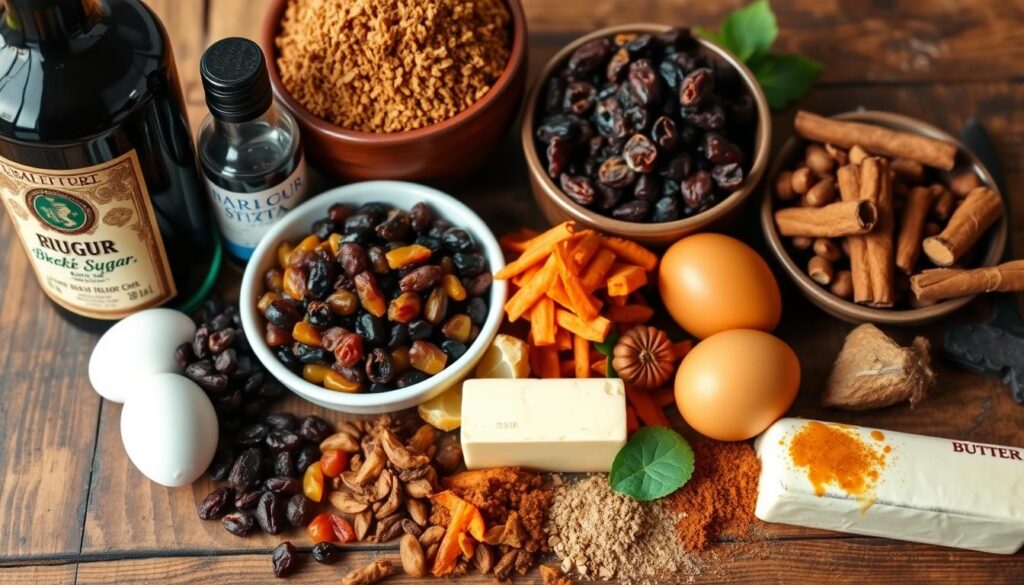
Making a true Jamaican or Trinidadian black cake needs the right ingredients. These ingredients turn simple parts into a rich, flavorful dessert. The secret is in the mix of fruits, spirits, and baking methods.
Key Ingredients for Caribbean Black Cake
- Dried Fruits
- Prunes
- Currants
- Raisins
- Dried cherries
- Spirits
- Dark rum
- Cherry brandy
- Wine
- Baking Essentials
- All-purpose flour
- Butter
- Brown sugar
- Eggs
- Baking powder
For a traditional Jamaican black cake, soaking dried fruits in rum and wine is key. You should soak them for at least one week. Some even soak them for months to get a deeper flavor.
“The secret to an exceptional black cake is patience and quality ingredients.” – Caribbean Baking Tradition
Trinidadian black cake needs careful attention. Each ingredient is important for its dense, moist texture and rich taste.
| Ingredient | Quantity | Purpose |
|---|---|---|
| Dried Fruits | 4 pounds | Provides depth and moisture |
| Rum | 2 cups | Enhances flavor and preservation |
| Butter | 1 pound | Creates rich, tender crumb |
| Eggs | 9-10 | Binds ingredients, adds structure |
Your black cake needs careful attention to ingredient quality and preparation. The result is a decadent dessert filled with Caribbean culinary heritage.
The Art of Fruit Preparation and Soaking
Making a great rum-soaked cake starts with careful fruit preparation. Turning dried fruits into a flavorful base is key. It’s what makes Caribbean black cake so rich and complex.
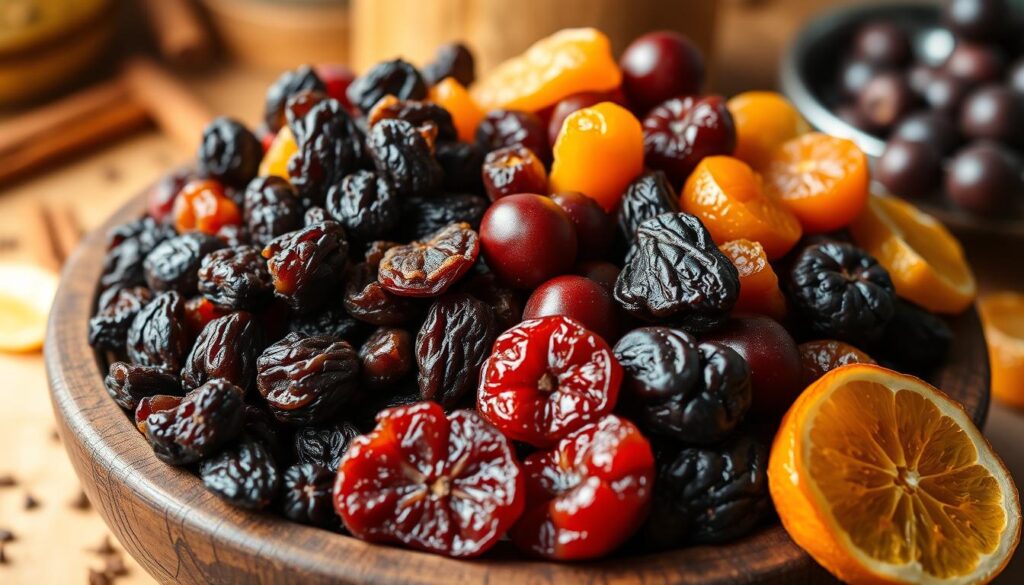
Selecting Premium Dried Fruits
To make a true soaked dried fruit cake, you need the right ingredients. The best mix includes:
- Raisins (golden and dark)
- Dried currants
- Candied cherries
- Dried prunes
- Candied mixed peel
Rum and Wine Soaking Techniques
Soaking dried fruits is where magic happens. Experts say to use Wray and Nephew Overproof White Rum or dark spiced rum. Pair it with Fairbanks Port wine for the best results.
“The secret is in the soak” – Caribbean Baking Wisdom
Optimal Soaking Duration
For the best flavor, be patient. Quick soaks of 15 minutes won’t cut it. Real recipes suggest:
- Minimum soaking time: 7 days
- Recommended duration: 4-12 weeks
- Traditional approach: Up to several months
Longer soaking times make the cake moist and rich. Keep your soaked fruit in an airtight container. This keeps it fresh and full of flavor.
Authentic Caribbean Black Cake: Step-by-Step Process
Making an authentic Caribbean black cake is all about precision and passion. It’s a journey that turns simple ingredients into a rich, flavorful dessert loved across the Caribbean.
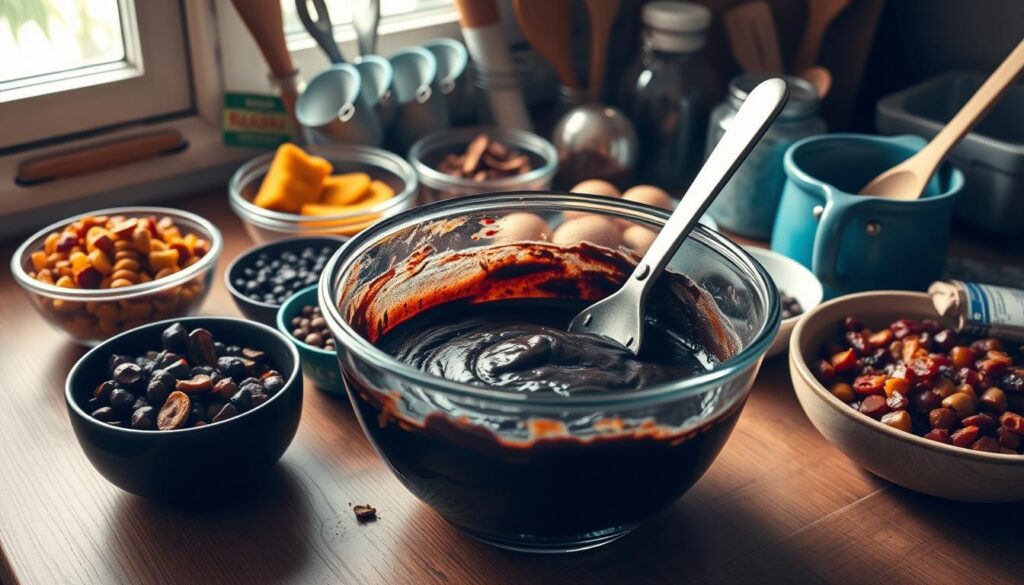
Your journey starts with a well-prepared fruit mixture. Begin by mixing:
- 1.5 lbs of macerated fruits (prunes, currants, raisins, glazed cherries)
- 3-4 cups of white or dark rum
- 750mL bottle of port wine
The fruit soaking process is key for deep, complex flavors. Expert bakers say soaking fruits for 3-4 months is a must, with some soaking for up to a year.
“A great Caribbean black cake is made with patience and love” – Caribbean Baking Tradition
For the batter, you’ll need:
- 10 ounces unsalted butter (room temperature)
- 1 cup granulated sugar
- 12 large eggs
- 2¼ cups all-purpose flour
- 2 teaspoons mixed spices
- 3 tablespoons browning sauce
Cream butter and sugar for 3-5 minutes until light and fluffy. Add eggs one at a time, making sure each is fully mixed. Then, gently mix in flour, spices, and the rum-soaked fruit. The goal is to keep the batter pudding-like.
Bake in an 8-inch round pan at 275-300°F for 60-80 minutes. A pro tip: bake 3-5 days before serving for the best flavor.
The Secret of Browning Sauce and Burnt Sugar
Every island heritage dessert has its own secret. For the molasses-infused cake, browning sauce is the magic that makes it special. This dark sauce gives the cake its deep, rich color, making it a Caribbean favorite.
Crafting Homemade Browning Sauce
Making your own browning sauce is easy. It’s all about caramelizing sugar until it turns dark. Here’s how to do it:
- Use 2 cups of brown sugar
- Heat sugar at medium temperature
- Stir continuously to prevent burning
- Add 1 cup of hot water gradually
- Cook until the mixture reaches a dark, almost black consistency
“The art of making browning sauce is about patience and careful attention – it’s the heart of our island heritage dessert.” – Caribbean Baking Tradition
Store-Bought Browning Alternatives
If you prefer convenience, store-bought browning sauce is a good choice. Here are some tips for choosing one:
- Look for pure, additive-free options
- Use sparingly – less than a teaspoon is typically enough
- Check for concentration levels
- Taste before adding to ensure no bitter undertones
Whether you make it yourself or buy it, browning sauce is key. It turns your molasses-infused cake into a masterpiece. It’s more than an ingredient; it’s a celebration of Caribbean cooking.
Mastering the Perfect Texture and Consistency
Making the perfect west indian fruitcake needs precision and knowing about texture. The caribbean christmas cake is famous for its soft, pudding-like feel that just melts in your mouth.
- Precise ingredient ratios
- Careful mixing techniques
- Controlled baking methods
- Proper fruit preparation
The success of your west indian fruitcake comes from knowing how each part works together. The dried fruit mix is key for adding moisture and flavor.
“A perfect caribbean christmas cake is like a culinary poem – every ingredient must harmonize.”
| Texture Factor | Impact on Cake |
|---|---|
| Fruit Soaking Duration | Enhances moisture and richness |
| Egg-to-Flour Ratio | Determines cake’s structural integrity |
| Baking Temperature | Influences final moisture content |
To get the best results, bake your caribbean christmas cake at about 275°F for 2-3 hours. This slow, low heat ensures it cooks evenly. It keeps the cake moist, which is why people love west indian fruitcake so much.
Pro tip: Rebaste your cake with rum every two weeks to keep it moist and boost its flavor.
Traditional Baking Techniques and Temperature Control
Making a jamaican black cake and trinidadian black cake needs special baking skills. It’s all about controlling the temperature and using the right baking methods. These steps help keep the cake’s rich flavor.
Baking a Caribbean black cake takes patience and care. Experts say it’s important to follow a certain way to get the cake just right. This ensures it’s moist and full of flavor.
Optimal Baking Temperature
The best temperature for baking a Caribbean black cake is between 275-300°F. This slow cooking method helps the cake cook evenly. It prevents it from burning and keeps it moist.
- Low temperature prevents exterior burning
- Ensures even heat distribution
- Maintains moisture in the cake
Testing for Doneness
To know if your jamaican black cake is done, you need to watch it closely. Experts use different ways to check if it’s ready:
- Insert a clean toothpick into the cake’s center
- Check for minimal crumb attachment
- Observe a golden-brown exterior
- Cake should spring back when gently pressed
“The secret to a perfect black cake is patience and precision in baking.” – Caribbean Culinary Tradition
| Baking Parameter | Jamaican Black Cake | Trinidadian Black Cake |
|---|---|---|
| Temperature Range | 275-300°F | 275-300°F |
| Typical Baking Time | 2-2.5 hours | 2-2.5 hours |
| Recommended Technique | Water Bath Method | Traditional Oven Baking |
By using these traditional baking methods, you’ll make a Caribbean black cake that’s a tribute to culinary traditions.
Post-Baking Care and Rum Soaking Process
After baking your Caribbean black cake, it’s important to take good care of it. This ensures it gets its rich flavor. The rum-soaked cake needs special attention for the best taste and to keep it fresh.
As soon as your cake comes out of the oven, start soaking it in rum. While it’s warm, use a pastry brush to apply more rum or wine. This helps the alcohol soak into the cake’s layers.
- Brush the cake with rum immediately after baking
- Use approximately 1/4 cup of rum per cake
- Apply rum in multiple light layers
- Allow each layer to absorb before adding the next
Pro tip: For an intensely flavored rum-soaked cake, repeat the rum brushing process every week for several months. This way, your cake gets a complex, deep flavor that gets better with time.
“The secret to an exceptional Caribbean black cake lies in patient, consistent rum application.” – Caribbean Baking Tradition
Keep your cake in an airtight container at room temperature. The ongoing rum soaking keeps the cake moist and enhances its flavor. This makes your dessert decadent and can last for weeks or months.
Storage and Aging Recommendations
Keeping your island heritage dessert fresh is key. Your traditional rum cake can stay moist and flavorful with the right storage. The cake’s alcohol content helps it last longer.
- Refrigerator storage: Up to 1 month
- Freezer preservation: Up to 10 years
- Cool, dry place: Approximately 1 month
Here are some expert tips for storing your rum cake:
- Wrap the cake tightly in plastic wrap
- Use an airtight container
- Add a light additional rum sprinkle before sealing
“The secret to a perfect Caribbean Black Cake is not just in its preparation, but in its careful preservation.” – Caribbean Culinary Traditions
The rum in your cake does more than just taste good. It also helps preserve the cake. This special mix lets the cake stay fresh for a long time.
It’s important to control the temperature and moisture. Keep the cake out of direct sunlight and extreme temperatures. With proper storage, your dessert will only get better with time.
Regional Variations Across the Caribbean
Exploring authentic Caribbean black cake takes you on a journey through a world of flavors. Each island in the West Indies adds its own twist to this beloved dessert. This turns one tradition into a colorful mix of tastes and methods.
Regional differences show the deep cultural roots in making authentic Caribbean black cake:
- Jamaica: Famous for its rum-soaked approach, creating an intensely rich flavor profile
- Trinidad and Tobago: Prefer sherry wine and often top their cake with bright red cherries
- Barbados: Known for a lighter texture and more delicate spice blend
- Antigua: Emphasizes longer fruit soaking periods, sometimes extending to several months
Ingredients play a big role in making each island’s fruitcake unique. While the basics stay the same, local tastes come through in the fruits, alcohol, and spices used.
“Every Caribbean island tells its story through its black cake” – Caribbean Culinary Traditions
The soaking process is where creativity really shines. Some bakers start making their fruit mixtures in January. This lets the flavors mature for December celebrations. The choice of rum or wine is also a source of pride, with each community having its favorite.
Looking into authentic Caribbean black cake is more than just a recipe. It’s a story of cultural strength, adaptation, and shared food traditions.
Conclusion
The Caribbean Christmas cake is more than a tasty treat. It’s a tradition that brings families together. Its complex flavors and detailed preparation make it a true celebration of Caribbean cooking.
Making a traditional Black Cake is more than baking. It connects you to the Caribbean’s rich history. Every step, from soaking fruits to browning, shares stories of strength and community.
By making this cake, you welcome Caribbean culture into your home. It’s perfect for holidays or special events. This cake is a delicious way to honor the Caribbean’s culinary spirit.
The Caribbean Christmas cake is a piece of heritage. It’s a tradition waiting to be shared and enjoyed.

